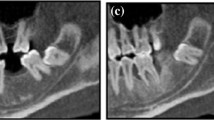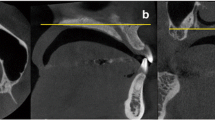Abstract
Purpose
The aim of the present study was to morphometrically analyze the mandibular canal through the mandibular ramus by cone beam computed tomography (CBCT) and to relate the findings to performing sagittal split ramus osteotomy.
Methods
CBCT of 200 patients were analyzed. Five parameters were measured at the axial scan, from the mandibular foramen to 21 mm below it (3-mm intervals). The canal was classified according to the position within the bone marrow space. Variations were evaluated according to age, sex, side, and number of mandibular teeth.
Results/conclusions
The following measurements increased gradually towards the most inferior level of measurement: the total thickness of the mandibular ramus through the center of the mandibular canal, the width of the bone marrow space (both buccal and lingual), and the narrowest width from the mandibular canal inner cortical to the mandibular ramus external cortical. The inner diameter of the mandibular canal slightly decreased to the same direction. Concerning the mandibular canal position within the bone marrow space, the percentage of the separate type increased towards the most inferior level of measurement, and the contact and fusion types decreased. Age, number of teeth, and sex had no significant influence on the total thickness of the mandibular ramus and on the narrowest width from the mandibular canal inner cortical to the mandibular ramus external cortical.




Similar content being viewed by others
References
Tsuji Y, Muto T, Kawakami J, Takeda S (2005) Computed tomographic analysis of the position and course of the mandibular canal: relevance to the sagittal split ramus osteotomy. Int J Oral Maxillofac Surg 34:243–246
Yamamoto R, Nakamura A, Ohno K, Michi KI (2002) Relationship of the mandibular canal to the lateral cortex of the mandibular ramus as a factor in the development of neurosensory disturbance after bilateral sagittal split osteotomy. J Oral Maxillofac Surg 60:490–495
Walter JM Jr, Gregg JM (1979) Analysis of postsurgical neurologic alteration in the trigeminal nerve. J Oral Surg 37:410–414
Yoshida T, Nagamine T, Kobayashi T, Michimi N, Nakajima T, Sasakura H, et al. (1989) Impairment of the inferior alveolar nerve after sagittal split osteotomy. J Craniomaxillofac Surg 17:271–277
Blomqvist JE, Alberius P, Isaksson S (1998) Sensibility following sagittal split osteotomy in the mandible: a prospective clinical study. Plast Reconstr Surg 102:325–333
Kaji M, Ohashi Y, Mutoh Y, Yagi M (1998) Study of late sensory paralysis in the lower lip after sagittal split osteotomy, part 1: investigation of factors on multivariate analysis. Niigata Dental Journal 28:1–6
Coghlan KM, Irvine GH (1986) Neurological damage after sagittal split osteotomy. Int J Oral Maxillofac Surg 15:369–371
Westermark A, Bystedt H, von Konow L (1998) Inferior alveolar nerve function after mandibular osteotomies. Br J Oral Maxillofac Surg 36:425–428
Westermark A, Bystedt H, von Konow L (1998) Inferior alveolar nerve function after sagittal split osteotomy of the mandible: correlation with degree of intraoperative nerve encounter and other variables in 496 operations. Br J Oral Maxillofac Surg 36:429–433
Brusati R, Fiamminghi L, Sesenna E, Gazzotti A (1981) Functional disturbances of the inferior alveolar nerve after sagittal osteotomy of the mandibular ramus: operating technique for prevention. J Maxillofac Surg 9:123–125
Rajchel J, Ellis E 3rd, Fonseca RJ (1986) The anatomical location of the mandibular canal: its relationship to the sagittal ramus osteotomy. Int J Adult Orthodon Orthognath Surg 1:37–47
Tamas F (1987) Position of the mandibular canal. Int J Oral Maxillofac Surg 16:65–69
Chrcanovic BR, Cavalcanti YS, Reher P (2009) Temporal miniplates in the frontozygomatic area—an anatomical study. Oral Maxillofac Surg 13:201–206
Chrcanovic BR, Custodio AL (2010) Anatomical variation in the position of the greater palatine foramen. J Oral Sci 52:109–113
Chrcanovic BR, Abreu MH, Custodio AL (2011) Morphological variation in dentate and edentulous human mandibles. Surg Radiol Anat 33:203–213
Chrcanovic BR, Abreu MH, Custodio AL (2011) A morphometric analysis of supraorbital and infraorbital foramina relative to surgical landmarks. Surg Radiol Anat 33:329–335
Chrcanovic BR, Custodio AL (2011) Optic, oculomotor, abducens, and facial nerve palsies after combined maxillary and mandibular osteotomy: case report. J Oral Maxillofac Surg 69:e234–e241
Chrcanovic BR, Freire-Maia B (2012) Risk factors and prevention of bad splits during sagittal split osteotomy. Oral Maxillofac Surg 16:19–27
MacIntosh RB (1981) Experience with the sagittal osteotomy of the mandibular ramus: a 13-year review. J Maxillofac Surg 9:151–165
Nishioka GJ, Zysset MK, Van Sickels JE (1987) Neurosensory disturbance with rigid fixation of the bilateral sagittal split osteotomy. J Oral Maxillofac Surg 45:20–26
Upton LG, Rajvanakarn M, Hayward JR (1987) Evaluation of the regenerative capacity of the inferior alveolar nerve following surgical trauma. J Oral Maxillofac Surg 45:212–216
Karas ND, Boyd SB, Sinn DP (1990) Recovery of neurosensory function following orthognathic surgery. J Oral Maxillofac Surg 48:124–134
August M, Marchena J, Donady J, Kaban L (1998) Neurosensory deficit and functional impairment after sagittal ramus osteotomy: a long-term follow-up study. J Oral Maxillofac Surg 56:1231–1235 discussion 1236
Valmaseda-Castellon E, Berini-Aytes L, Gay-Escoda C (2001) Inferior alveolar nerve damage after lower third molar surgical extraction: a prospective study of 1117 surgical extractions. Oral Surg Oral Med Oral Pathol Oral Radiol Endod 92:377–383
Bruce RA, Frederickson GC, Small GS (1980) Age of patients and morbidity associated with mandibular third molar surgery. J Am Dent Assoc 101:240–245
Naples RJ, Van Sickels JE, Jones DL (1994) Long-term neurosensory deficits associated with bilateral sagittal split osteotomy versus inverted ‘L’ osteotomy. Oral Surg Oral Med Oral Pathol 77:318–321
Hara S, Mitsugi M, Kanno T, Tatemoto Y (2013) Clinical approach for mandibular advancement by intraoral vertical ramus osteotomy with endoscopically assisted intraoral fixation of an L-shaped compact lock plate. J Craniofac Surg 24:545–547
Simpson W (1981) Problems encountered in the sagittal split operation. Int J Oral Surg 10:81–86
Wolford LM, Bennett MA, Rafferty CG (1987) Modification of the mandibular ramus sagittal split osteotomy. Oral Surg Oral Med Oral Pathol 64:146–155
Loh FC (1992) Technical modification of the sagittal split mandibular ramus osteotomy. Oral Surg Oral Med Oral Pathol 74:723–726
Trauner R, Obwegeser H (1957) The surgical correction of mandibular prognathism and retrognathia with consideration of genioplasty. I. Surgical procedures to correct mandibular prognathism and reshaping of the chin. Oral Surg Oral Med Oral Pathol 10:677–689
Acknowledgments
This research received no specific grant from any funding agency in the public, commercial, or not-for-profit sectors.
Author information
Authors and Affiliations
Corresponding author
Ethics declarations
The authors declare that they have no conflict of interest. All persons gave their informed consent prior to the inclusion of their CBCT examinations in the study. The study was approved by the local Ethics Committee.
Rights and permissions
About this article
Cite this article
Chrcanovic, B.R., de Carvalho Machado, V. & Gjelvold, B. A morphometric analysis of the mandibular canal by cone beam computed tomography and its relevance to the sagittal split ramus osteotomy. Oral Maxillofac Surg 20, 183–190 (2016). https://doi.org/10.1007/s10006-016-0550-9
Received:
Accepted:
Published:
Issue Date:
DOI: https://doi.org/10.1007/s10006-016-0550-9




